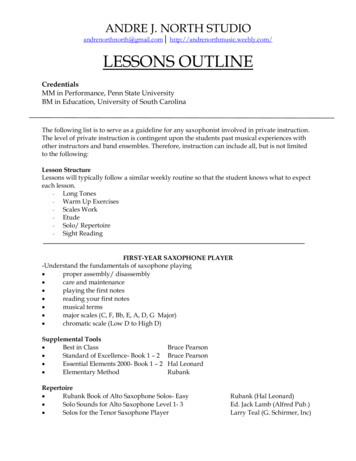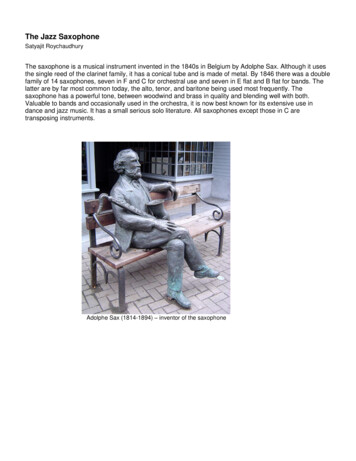
Transcription
THEBASIC BAND BOOKa project by Mr. GlynnSAXOPHONETHIS BOOK BELONGS TO
Before we begin YOU AREC R E AT I V EYOU ARE AMUSICIANYOUCAN-3-DOTHIS
THE MUSICAL ALPHABETFORWARDSBACKWARDSE F G A B C D E F G A B CGFAEBCDA-4-BCDEFGFEDCBA
Q & A ––––1) What letter comes after G ?2) When we move forwards in the alphabet, does the sound go up or down?3) When we move backwards in the alphabet, does the sound go up or down?PENCIL GAMES ��–––––––––––WITHOUT looking at the previous page, fill in the missing letters:forwards:1)A D C2)E B Fbackwards:3)C B F A4)F G CBAND @ HOMEwww.BasicBand.info1) Use the video online to help you.2) Say the Musical Alphabet forwards and backwards 5 times in a row perfectlywithout looking at it.3) Challenge your friends and family to say the Musical Alphabet forwards andbackwards and see who can do it well.-5-
BREATH SUPPORTBreath Support: how we use our air to play a wind instrument.Use your stomach to push the air up and out of your body.BUILDING LUNG CAPACITY ) Breathe air IN like you are whispering the letterO2) Breathe air OUT like you are whispering the wordTOEALWAYS DO THIS WITH EXCELLENT POSTUREUSE AS MUCH AIR AS POSSIBLESITTING UP STRAIGHT & TALLKEEP YOUR SHOULDERS RELAXED!-6-
BREATHING EXERCISES ��––At the same speed as the second-hand of a clock:1) Breathe IN for 4 countsOUT for 4 counts2) Breathe IN for 3 countsOUT for 5 counts3) Breathe IN for 2 countsOUT for 6 counts4) Breathe IN for 1 countOUT for 7 countsMAKE UP SOME OF YOUR OWN COMBINATIONS!BAND @ HOMEwww.BasicBand.info1) Carefully cut out the four bulls-eyes on the next page.2) Challenge your friends and family to see who can blow a bulls-eye againstthe wall for the longest amount of time (aim right for the center!).3) Go through the steps above sitting with good posture.-7-
-8-
-9-
- 10 -
Saxophone Lesson 1SAXOPHONE PLAYING POSITIONTHINGS TO REMEMBER ��––– Adjust the neck strap so theinstrument comes to you, and youdon’t have to move towards theinstrument. The bell should touch the outside ofyour right knee. Sit up straight and tall, and on theedge of your seat.BAND @ HOMEwww.BasicBand.info1) Watch the video online to helpyou assemble the saxophoneproperly.- 11 -
Saxophone Lesson 3SAXOPHONE EMBOUCHUREEmbouchure: how to form your mouth to play an instrument.THE FOUR STEPS ��–––––––––1) Say the word VO really slowly V V V V V V V V V V O O O O O O O O O O OThis sets your mouth in the proper position2) Rest your top teeth on top of the mouth piece3) Close your lips around the rest of the mouth piece like you are saying “VO”4) And blowALWAYS REMEMBER ��–––––VO- 12 -
TROUBLESHOOTING ��–––––– Make sure to bite down on the mouthpiece with a little bit of pressure Your lips should cover the mouthpiece so no air can escapeBAND @ HOMEwww.BasicBand.info1) Go through all of the steps above. Watch the video online to help you.2) Use a mirror to see what your embouchure looks like.3) Make a good sound on your Saxophone 5 times in a row, taking it away fromyour mouth after each time.4) Show someone at home how to make a sound!- 13 -
Saxophone Lesson 4HOLDING THE SAXOPHONELEFT HANDON TOPRIGHT HANDON BOTTOM- 14 -
RIGHT HAND ��–––––––––––––1) Your right hand should beholding the imaginary waterbottle. Place your thumbunder the thumb rest.2) Place your three fingers overthe three white circle keys inthe lower section. Use yourfinger tips only.FINGER POSITION ��––––––––This is the specific part of thefinger which covers the keys. Ifyour finger does not cover thekey properly, air will escape andit will cause shrill and squeakynoises when playing.- 15 -
LEFT HAND ��–––––––––––––––1) Your left hand should also hold an imaginary water bottle.2) The thumb either sits on the black circle or pushes the silver key in theback.3) The finger tips cover the three keys in the front. Skip the 2nd key down.12BAND @ HOME3www.BasicBand.info1) Use the video online to help you.2) Make a sound with only your right hand fingers down, then with only your lefthand fingers down, then with both hands down.3) Go teach someone at home how to play this sound!- 16 -
Saxophone Lesson 7TONGUINGTonguing: how we start the sound with the tongueHOW TO TONGUE ��––––––––1) Say the word THE. Say it slowly TTTTTHHHHHHHEEEEEEEE2) You will feel your tongue go against the bottom of your teeth.3) Play a D, and bring your tongue to the reed like you are saying THETROUBLESHOOTING ��–––––– Don’t let your tongue stop the reed from vibrating. It just needs todampen it. You should still hear a sound when your tongue is resting onthe reed. It might tickle at first you just need to get used to it.BAND @ HOMEwww.BasicBand.info1) Go through all of the steps above. Watch the video online to help you.2) Play a D, and go back and forth placing your tongue on the reed. Start slowlyand gradually speed up.3) Challenge yourself to see how long you can keep your tongue on the reedwithout it stopping the sound.- 17 -
SAXOPHONE FINGERINGSALWAYS REMEMBER ��–––––1) Keep your fingers close to the keys, always ready to push down.FINGER POSITION ��––––––––This is the specific part of thefinger which covers the keys. Ifyour finger does not cover thekey properly, air will escape andit will cause shrill and squeakynoises when playing.BAND @ HOMEwww.BasicBand.info1) Use the video to help you.2) Ask someone to watch you play these notes and have them look to see ifyour fingers are staying close to the keys or coming off too far.- 18 -
LEFT HANDBAGRIGHT HANDFED- 19 -
G is DOTIDOREMIGQ & A ––––1) Is this Major or minor?2) Which note is your resting tone?- 20 -
E is LASILATIDOREMIEQ & A ––––1) Is this Major or minor?2) Which note is your resting tone?- 21 -
C is DOTIDOREMICQ & A ––––1) Is this Major or minor?2) Which note is your resting tone?- 22 -
A is LALATIDOREMIAQ & A ––––1) Is this Major or minor?2) Which note is your resting tone?- 23 -
CHROMATIC SCALEGG#ORAbAA#ORBb- 24 -B CC#ORDb
DD#OREbE FF#ORGbGALWAYS REMEMBER ��–––––1) The Chromatic Scale is when you play every note on the instrument, in order,up or down.2) When you go up, use sharps ( # ). When you go down, use flats ( b ).3) It can start and end on any note.- 25 -
MUSIC NOTATIONjust like you take notes to help you remember what yourteacher told you, we also have notes in music. They existto remind you of what you have already learned.It is called Music Notation.BAND @ HOMEwww.BasicBand.info1) Watch the Lesson for Everyone video called “Music Notation” to be sure youunderstand it.- 26 -
STEP 1 – Hold out your hand.5 How many fingers do you have?4How many spaces in betweenthose fingers?4332211STEP 2 –Just like you have lined paper towrite notes on, we also have aspecial type of lines, called amusic staff. The staff has 5 lines, and 4 spacesin between the lines just like yourhand. ��––––––––––––––STEP 3 – Let’s recall some of the solfége syllables:SOFAMIREDOTILA- 27 -
STEP 4 – We can make any line or any space on the staff The picture below showsDODOon the 2nd ��––––––––––––– As long as we know whereeverything else isDOis, we can figure out whereSTEP 5 – When we write notes on the music staff, they alternate between lines andspaces:line – space – line – space – line – space – line – space – line Think about what the solfége syllables for the rest of the lines and spacesare going to �––––––––––––- 28 -
STEP 6 – Instead of writing the syllables on every line and space, we are going to drawa line to show us where DO isTo tell us which pitch to sing or play, we are going to draw oval notes on itsline or –––––––––STEP 7 – The arrow points to DO Write in the rest of the solfége syllables Sing these - 29 -
- 30 -
MAJOR TONAL PATTERNSDO is �––––––Be expressive when performing with your voice and with your instrument!- 31 -
DUPLE RHYTHM PATTERNS12345678Be expressive when performing with your voice and with your instrument!- 32 -
TRIPLE RHYTHM PATTERNS12345678Be expressive when performing with your voice and with your instrument!- 33 -
- 34 -
PLAYING RECORDOnly check off each day that you spend at least 10 minutes playing your instrument.DATEASSIGNMENT9/5The Musical Alphabet - p. 4M Tu W Th F Sa SuPARENT/GUARDIANSIGNATURER.Glynn- 35 -
1) Go through all of the steps above. Watch the video online to help you. 2) Use a mirror to see what your embouchure looks like. 3) Make a good sound on your Saxophone 5 times in a row, taking it away from your mouth after each time. 4) Show someone at home how to make a sound!











